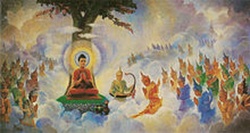Trāyastriṃśa
The Trāyastriṃśa (Sanskrit; Pāli Tāvatiṃsa; Burmese: တာဝတိံသာ [tàwədèɪɴðà]) Heaven is an important world of the devas in Buddhist cosmology. The word trāyastriṃśa is an adjective formed from the numeral trayastriṃśat, "33" and can be translated in English as "belonging to the thirty-three devas". It is primarily the name of the second Heaven in Buddhist cosmology, and secondarily used of the devas who dwell there.
Trāyastriṃśa (Sanskrit; Pāli, tāvatiṃsa). A heavenly realm located, according to traditional cosmology, on top of Mt. Meru above the realm of the four great kings (caturmahārāja; lokapāla) who guard the cardinal points. Śakra (Pāli, Sakka) is the king of both these worlds. Occasionally sages visit this realm and according to tradition the Buddha spent some months there teaching the Abhidharma to his mother when she was reborn in this heavenly realm. Mahāmaudgalyāyana was also a frequent visitor. The name ‘thirty-three’ derives from the fact that this world is the residence of the 33 gods of Hinduism, an ancient mythological notion originating in vedic times.
The Trāyastriṃśa Heaven is the second of the heavens of the Kāmadhātu, and the highest of the heavens that maintains a physical connection with the rest of the world. Trāyastriṃśa is located on the peak of Sumeru, the central mountain of the world, at a height of 80,000 yojanas (a height sometimes equated to about 40,000 feet); the total area of the Heaven is 80,000 yojanas square. This Heaven is therefore comparable to the Greek Olympus in some respects.
According to Vasubandhu, inhabitants of Trāyastriṃśa are each half a krośa tall (about 1500 feet) and live for 1000 years, of which each day is equivalent to 100 years of our world: that is, for a total of 36 million of our years.
Since Trāyastriṃśa is physically connected to the world through Sumeru, unlike the heavens above it, the Trāyastriṃśa gods are unable to avoid being entangled in worldly affairs. In particular, they frequently find themselves in quarrels with the Asuras, semi-divine beings who were long ago expelled from Trāyastriṃśa, at the beginning of the reign of the present Śakra and who now dwell at the foot of Sumeru, plotting for ways to recover their lost kingdom. There is, however, marriage between the Trāyastriṃśa devas and the Asuras, just as there is between the Æsir and the jötnar in Norse mythology.
The chief of the Trāyastriṃśa gods is Śakra (Pāli: Sakka). Others of the Trāyastriṃśa gods who are frequently mentioned are Viśvakarman (Vissakamma), the gods' craftsman and builder; Mātali, who drives Śakra's chariot; and Sujā, Śakra's wife and daughter of the Asura chief Vemacitrin.
The thirty-three gods (trāyastriṃśa) who live on the top of Mt. Sumeru in the second of the six heavens of the desire realm 六欲天. Śakra 帝釋天 dwells in the center with eight other gods in each of the four directions. Also rendered with the hybrid transcription/translation as 忉利天. The Trāyastriṃśa Heaven appears several times in Buddhist stories, in which either The Buddha ascends to Trāyastriṃśa, or (more often) deities from Trāyastriṃśa descend to meet The Buddha. The Buddha's mother, Māyādevī, was reborn in the Trāyastriṃśa Heaven and was visited by her son, who taught her Abhidharma.
The "thirty-three" in the name of the Heaven is not an enumeration of the gods who live there (there are far more) but a general term inherited from Vedic mythology, implying "the whole pantheon of gods". Hindu mythology provides a full list (with some variations) of thirty-three named deities, but it is inconsistent with the Buddhist conception and mythology of these devas.
